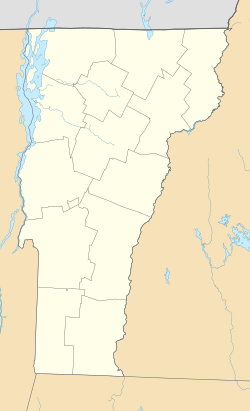Bethel Village Historic District facts for kids
|
Bethel Village Historic District
|
|

View of White River, with Main Street buildings on the left, January 2007
|
|
| Location | Both sides of S. Main, Main, N. Main, and Church Sts.; also River Rd. to the White River, Bethel, Vermont |
|---|---|
| Area | 55 acres (22 ha) (original) 2.5 acres (1.0 ha) (size of 1990 increase) |
| Built | 1779 |
| Architectural style | Greek Revival, Federal, Italianate Revival |
| NRHP reference No. | 76000199 (original) 90000797 (increase) |
Quick facts for kids Significant dates |
|
| Added to NRHP | September 3, 1976 |
| Boundary increase | May 24, 1990 |
The Bethel Village Historic District is a special area in the village of Bethel, Vermont, USA. It's like a preserved snapshot of history! This district includes many old buildings. You can find homes, shops, and important town buildings here. These buildings show what the village looked like in the 1800s and early 1900s.
This historic district was added to the National Register of Historic Places in 1976. This means it's recognized as an important place in American history. A few years later, in 1990, the district was made a little bit bigger to include even more historic spots.
Contents
What is the Bethel Village Historic District?
The village of Bethel is located in central southern Vermont. It sits in the beautiful White River valley. The village grew up around the White River and its smaller branch, the Third Branch White River. The river was very important because it provided power for early mills.
How did Bethel Village start?
The town of Bethel was officially created in 1779. Soon after, people built a sawmill and a gristmill near the river's waterfalls. These mills used the river's power to cut wood and grind grain. This helped the community grow.
Bethel also became a stop on the main road that followed the river. This road was used by stagecoaches, which were like early buses. Later, in 1849, the railroad came to Bethel. This made the village even more important for trade and travel.
Fires and rebuilding
Over the years, Bethel faced some challenges. A big fire in 1877 destroyed part of the downtown area. But the people of Bethel rebuilt! They used stronger, more fire-resistant materials for the new buildings.
In the late 1800s, the village also benefited from a nearby granite quarry. Granite is a very strong stone. Stone from Bethel was used in many important buildings in the eastern United States. More fires happened in 1938 and 1945, causing more damage to the downtown.
Exploring the historic district
The historic district follows Main Street and Church Street. These streets are part of Vermont Route 12. The district starts near River Street and goes to Pleasant Street. It also includes small parts of North Main Street and River Street.
Along Main Street, you'll see many old commercial buildings. These are shops and businesses from the 1800s. Many of them are two or three stories tall. Near the intersection of Main and Church Streets, you'll find town buildings. Church Street has several churches and old homes. The buildings in the district show many different styles from the early 1800s to the early 1900s.



